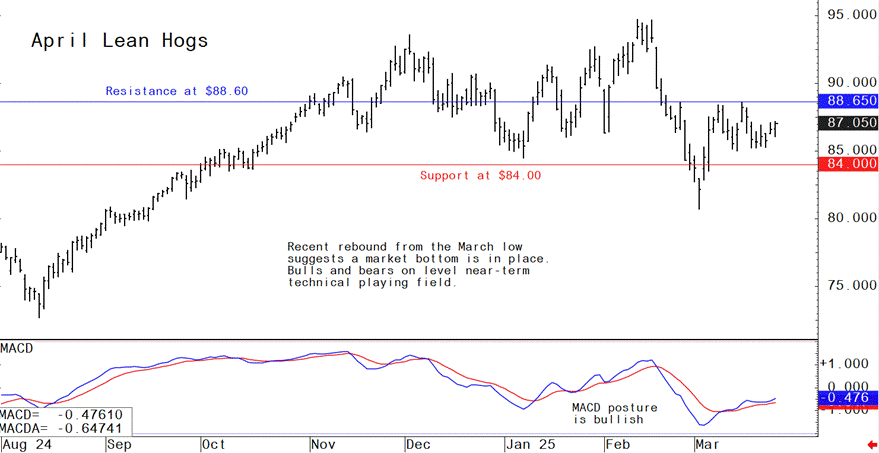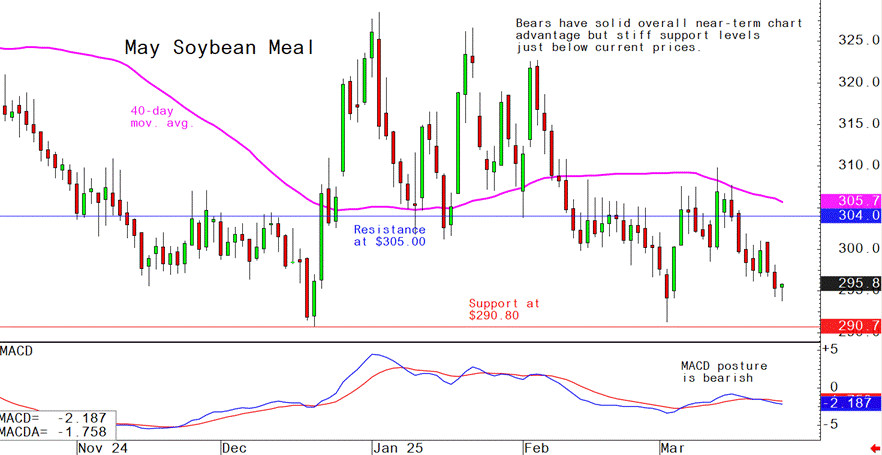



Pig outlook: Lean hog futures trading remains choppy, sideways
Livestock analyst Jim Wyckoff reports on global pig newsApril lean hog futures prices have been trading sideways and choppy for the past nearly three weeks. The bulls and bears are presently on a level overall near-term technical playing field. The latest CME lean hog index is up 11 cents to $88.90 as of March 24, supported by recent strength in pork cutout. Cutout rose 18 cents to $97.55 Tuesday. Strength in bellies led cutout higher.
Tuesday’s fresh pork movement rose to 375.51 loads, suggesting good demand for pork. The narrowing discount April futures hold to the cash hog index did has limited selling interest in futures this week. Lean hog futures bulls are taking note of the still-solid consumer demand for pork at the meat counter, as retail beef prices remain at historically high levels.
Latest USDA and other news regarding the global pork industry
The size of the US hog herd was about 1.2% bigger on March 1 than a year earlier, a Reuters survey of analysts showed, just ahead of the USDA’s quarterly Hogs and Pigs report due out Thursday afternoon.
Slovakia declares 'emergency situation' to stop foot-and-mouth spread
Slovakia declared an emergency situation on Tuesday, making it easier to enact measures to prevent the spread of cases of foot-and-mouth disease (FDM) after infections were detected in the southern part of the country, Reuters reported, citing the government office on its website. Officials discovered the cases at three farms last week. The infections were the first in half a century, and come after neighboring Hungary reported cases earlier in March. FMD poses no danger to humans but causes fever and mouth blisters in cloven-hoofed ruminants such as cattle, swine, sheep and goats, and outbreaks often lead to trade restrictions.
Brazil government confirms Japanese mission to inspect beef, pork and poultry plants
The Brazilian government on Tuesday confirmed a Japanese mission will visit the South American country to inspect its slaughterhouses, Reuters reported, citing a government statement. After a meeting involving the agriculture ministers of both countries, Brazil said "this step is essential for opening the Japanese market to Brazilian beef" and for expanding access to Brazilian pork exports into Japan. No timing was provided.
USDA lowers overall food inflation outlook, but egg prices soar
USDA trimmed its forecast for overall food price inflation in 2025, despite sharply raising its projection for egg prices due to ongoing bird flu impacts.
USDA now expects food prices to rise 3.2% in 2025, slightly down from its February forecast of 3.4%. Grocery (food-at-home) prices are projected to climb 2.7%, compared to the prior estimate of 3.3%. In contrast, restaurant (food-away-from-home) prices are now expected to rise 3.7%, up from February’s 3.4% forecast.
Despite the lowered overall outlook, all three categories are still projected to rise above their 20-year averages: 2.9% for all food, 2.6% for groceries, and 3.5% for restaurants. In 2024, all food prices rose 2.3%, grocery prices were up 1.2%, and restaurant prices increased 4.1%.
Egg prices spike amid avian flu outbreak. The most dramatic change comes in the forecast for eggs, with USDA now projecting a record 57.6% increase in 2025 — up sharply from the 41.1% forecast in February and far higher than the 8.5% increase seen in 2024. Retail egg prices surged 12.5% in February 2025 alone, following double-digit gains in January and December. USDA attributes the price volatility to the highly pathogenic avian influenza (HPAI) outbreak, which affected about 30 million commercial egg-laying hens in early 2025. Although detections eased in March, USDA notes that retail prices typically lag behind changes in wholesale prices, which have recently declined.
Mixed shifts in other food categories. Several food categories are now forecast to be cheaper in 2025 than in 2024:
- Pork: Down 1.5% (vs. +1.2% in February)
- Other meats: Down 0.2% (vs. +0.6%)
- Poultry: Down 0.4% (vs. unchanged)
- Dairy: Down 0.8% (vs. +2.2%)
Beef and veal prices, however, are expected to climb 5.2% in 2025, up from the February forecast of 3.2%. Beef and veal prices are now forecast to rise 5.2% in 2025 versus an outlook for an increase of 3.2% in February.
Why overall grocery inflation remains moderate. Although egg prices are surging, their limited weight in the index — just 1.4% of total food prices — helps explain why the overall grocery inflation outlook was revised lower. In contrast, food at home accounts for 58.9% of the food component of the CPI, while restaurant spending makes up 41.1%.
USDA emphasizes that its forecasts reflect the annual average change in prices for 2025 compared to 2024, not month-to-month or year-end inflation. Some of the projected increases for 2025 have already materialized in early-year data.
Bottom line: Even with a slower pace of inflation compared to recent years, the trend remains clear: US consumers will still pay more for food in 2025 than they did in 2024.
The next week’s likely high-low price trading ranges:
April lean hog futures--$84.00 to $88.60 and with a sideways bias
May soybean meal futures--$290.80 to $309.80, and with a sideways bias
May corn futures--$4.50 to $4.70 and a sideways bias
Latest analytical daily charts lean hog, soybean meal and corn futures










